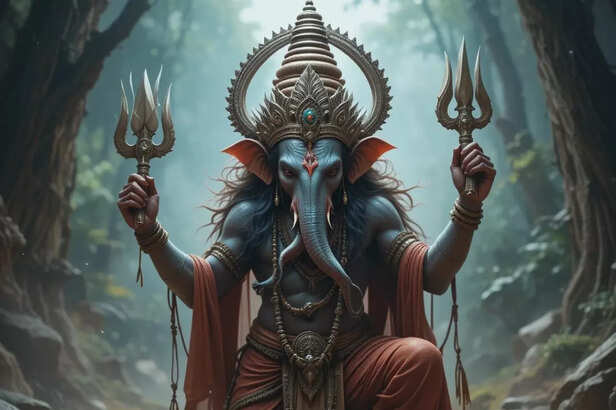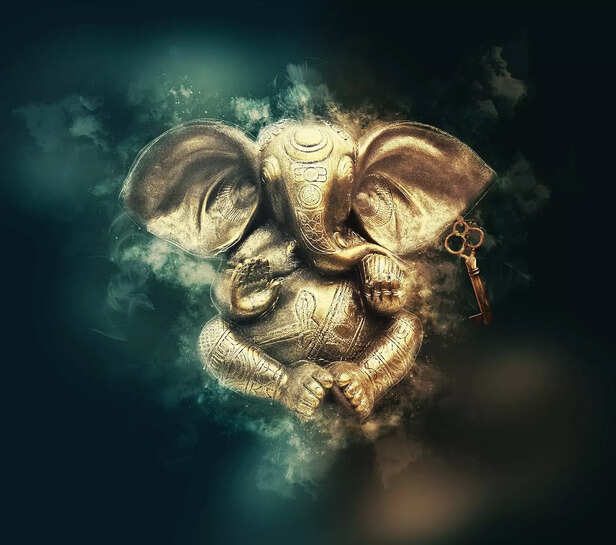The Terrifying, Hidden Avatar of Ganesha – Aghora Ganpati
Ankit Gupta | Apr 18, 2025, 21:07 IST
Aghora Ganpati
This form is Aghora Ganpati—the mysterious and fearsome Ganesha known only to Tantrics, Aghoris, and those who dare walk the left-hand path (Vamachara). He is not the Ganesha of laddoos and mantras. He is the Ganesha of skulls, fire, and the void.
When most people think of Lord Ganesha, the image that arises is that of the gentle, elephant-headed deity—the remover of obstacles, the embodiment of joy, intellect, and auspiciousness. Known fondly as "Vighnaharta," he is called upon at the start of every new journey—academic, spiritual, or worldly. But what if there existed a form of Ganesha that was terrifying, raw, and hidden? One that did not offer comfort, but confrontation? Within the cryptic corridors of Tantra and Aghora lies this forgotten and fearsome deity—Aghora Ganpati. A form not worshipped in public temples, not adorned with garlands of marigolds, but cloaked in mystery, fire, and skulls.
Beyond the Sweetness: The Forgotten Path of

Mainstream Hinduism offers a calm, benevolent image of Ganesha. But in the esoteric realms of Tantra, especially in the Aghora and Kaula traditions, his role is far more complex—and far more powerful. In these traditions, Ganesha is not merely the opener of new ventures. He is the Lord of Thresholds, the first and most important guardian who must be crossed before entering deeper spiritual realms. He becomes the fierce protector, the annihilator of illusion, and the commander of energies that lie beyond the veil.
This fierce form is known as Aghora Ganpati—a form that exists in secret Tantric texts like the Rudra Yamala Tantra, Ganesha Tantra, and other oral traditions guarded for centuries. Unlike the gentle Ganesha of public devotion, Aghora Ganpati emerges not in bright sanctuaries but in the shadows of the cremation ground, or smashan, where all identities dissolve.

Aghora Ganpati is not your festival Ganesha. He is not seen in home temples or sweet-scented shrines. This is a form known only to the few who walk the left-hand path (Vamachara) of Tantra—a path of power, dissolution, and liberation. In this terrifying manifestation:

Why would the same deity of joy and wisdom take such a terrifying form? The answer lies in the nature of real transformation. Truth is not always beautiful. It is often brutal. To grow spiritually is not just to chant and meditate, but to be ready to burn down the house of false identity. And this burning is exactly what Aghora Ganpati initiates.
He represents the raw force needed to dismantle ego, dissolve desires, and destroy illusions. While the gentle forms of Ganesha help in worldly progress, Aghora Ganpati guides the seeker toward spiritual death and rebirth—the only way to liberation. His path is not one of comfort, but of confrontation. He does not smile—he roars.
For practitioners of the left-hand path, Aghora Ganpati is the first deity to be invoked. Before the soul can walk into the terrifying wilderness of absolute truth, it must first cross him—the gatekeeper of the unknown.
Every terrifying element of Aghora Ganpati is deeply symbolic. The garland of skulls represents the severed heads of ignorance, lust, greed, and ego. It is not a celebration of death, but of awakening. The cremation ground, or smashan, is not just a physical space—it is the symbolic end of all attachments. It reminds us that no matter our status, wealth, or knowledge, all bodies meet the fire.
His weapons are not tools of violence, but instruments of clarity. The sword cuts through illusion. The fire burns impurities. The noose pulls the wandering mind back to the self. The trident signifies mastery over the three gunas—sattva, rajas, and tamas. Aghora Ganpati stands amidst this symbolism not as a punisher, but as a liberator—harsh, but just.
Even his mount, when it appears, is not the gentle mouse (Mushika) of popular lore, but a lion—representing the fearless power of dissolution and transcendence.
This terrifying form of Ganesha is not for everyone—and it is not meant to be. Aghora Ganpati is not invoked for material gains or blessings. His energy is invoked by those who are ready to die to themselves, to face their inner shadows, to destroy falsehood with fire. He is the deity of those who walk the pathless path, where rules do not apply and only truth survives.
He is invoked in advanced Tantric rituals, often in cremation grounds or in extreme solitude. The sadhaka (practitioner) who calls upon him must be fearless, honest, and ready to surrender everything. Only then does Aghora Ganpati reveal himself—not as a monster, but as a mirror, reflecting the soul’s purest truth through terrifying compassion.
While the world celebrates the joyful, pot-bellied, kind-hearted Ganesha, the seeker who yearns for ultimate liberation must eventually meet his Aghora form. This is the Ganpati of fire, ash, and thunder—the one who doesn’t remove worldly obstacles, but the one who removes the self.
To meet him is to die, but in that death, the eternal truth awakens. That is Aghora Ganpati—not a deity of comfort, but of cosmic transformation.
Beyond the Sweetness: The Forgotten Path of Ganesha in Tantra

Lord Ganpati
Mainstream Hinduism offers a calm, benevolent image of Ganesha. But in the esoteric realms of Tantra, especially in the Aghora and Kaula traditions, his role is far more complex—and far more powerful. In these traditions, Ganesha is not merely the opener of new ventures. He is the Lord of Thresholds, the first and most important guardian who must be crossed before entering deeper spiritual realms. He becomes the fierce protector, the annihilator of illusion, and the commander of energies that lie beyond the veil.
This fierce form is known as Aghora Ganpati—a form that exists in secret Tantric texts like the Rudra Yamala Tantra, Ganesha Tantra, and other oral traditions guarded for centuries. Unlike the gentle Ganesha of public devotion, Aghora Ganpati emerges not in bright sanctuaries but in the shadows of the cremation ground, or smashan, where all identities dissolve.
Who is Aghora Ganpati? The Ganesha Few Dare to Know

Aghora Ganpati
Aghora Ganpati is not your festival Ganesha. He is not seen in home temples or sweet-scented shrines. This is a form known only to the few who walk the left-hand path (Vamachara) of Tantra—a path of power, dissolution, and liberation. In this terrifying manifestation:
- He has ten arms, each bearing powerful symbols: a trident, a skull, a sword, a noose, a fire pot, and other mystical weapons.
- He wears a garland of skulls, not to invoke violence, but to signify the death of ignorance.
- His eyes are bloodshot, blazing with divine fury—not hatred, but the fierce light of truth.
- He stands in the cremation ground, surrounded by ashes, where the illusion of ego ends.
- He is accompanied by spirits, ghosts, and celestial beings that exist in realms most are afraid to perceive.
- Sometimes, he rides a lion, sometimes nothing at all. He becomes the very storm of transformation.
Why Is He So Fearsome? The Fire of Truth

Source: Pixabay
Why would the same deity of joy and wisdom take such a terrifying form? The answer lies in the nature of real transformation. Truth is not always beautiful. It is often brutal. To grow spiritually is not just to chant and meditate, but to be ready to burn down the house of false identity. And this burning is exactly what Aghora Ganpati initiates.
He represents the raw force needed to dismantle ego, dissolve desires, and destroy illusions. While the gentle forms of Ganesha help in worldly progress, Aghora Ganpati guides the seeker toward spiritual death and rebirth—the only way to liberation. His path is not one of comfort, but of confrontation. He does not smile—he roars.
For practitioners of the left-hand path, Aghora Ganpati is the first deity to be invoked. Before the soul can walk into the terrifying wilderness of absolute truth, it must first cross him—the gatekeeper of the unknown.
The Symbolism Behind the Skull Garland and Cremation Ground
His weapons are not tools of violence, but instruments of clarity. The sword cuts through illusion. The fire burns impurities. The noose pulls the wandering mind back to the self. The trident signifies mastery over the three gunas—sattva, rajas, and tamas. Aghora Ganpati stands amidst this symbolism not as a punisher, but as a liberator—harsh, but just.
Even his mount, when it appears, is not the gentle mouse (Mushika) of popular lore, but a lion—representing the fearless power of dissolution and transcendence.
Walking the Path: Who Can Invoke Aghora Ganpati?
He is invoked in advanced Tantric rituals, often in cremation grounds or in extreme solitude. The sadhaka (practitioner) who calls upon him must be fearless, honest, and ready to surrender everything. Only then does Aghora Ganpati reveal himself—not as a monster, but as a mirror, reflecting the soul’s purest truth through terrifying compassion.
Aghora Ganpati – The Guardian of Ultimate Truth
To meet him is to die, but in that death, the eternal truth awakens. That is Aghora Ganpati—not a deity of comfort, but of cosmic transformation.
